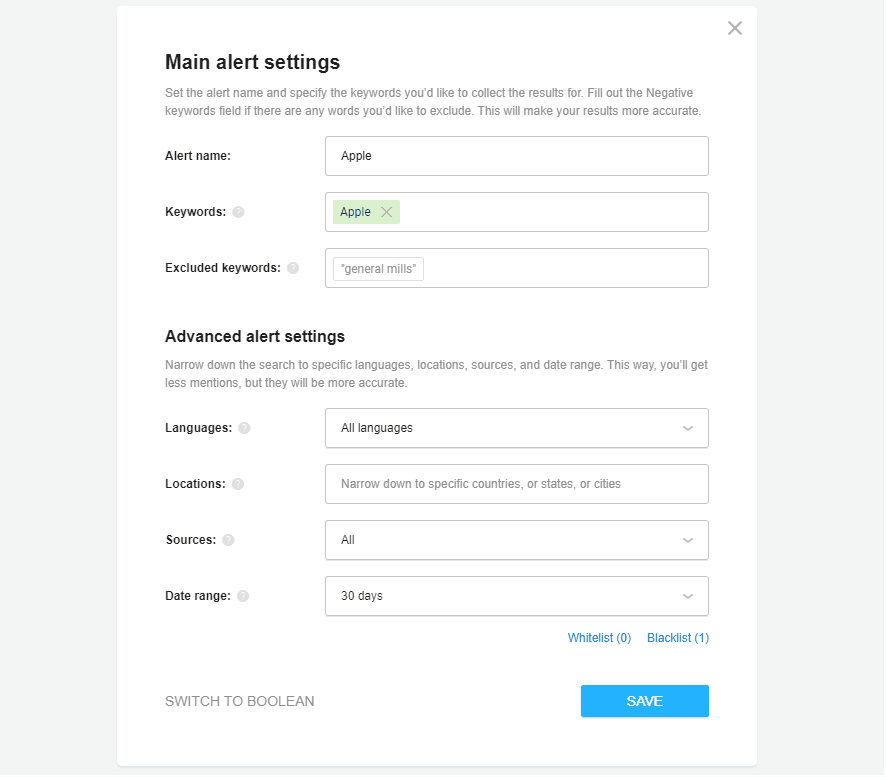What social listening tool is not: most popular prejudices

Article summary
Social listening is a niche that sounds so similar to other social media-related terms. It is often confused with other dramatically different concepts. In this article, we’ll do our best to draw lines between this host of social media terms and explain what social listening tools can be used for.
One can argue that the current pandemic has given a second wind to the digital transformation process. With businesses of all kinds going online at an even higher pace, digital marketing has to follow suit and keep up with the developments. Luckily, recent years have yielded a wide variety of tools to help marketers weather the ever-shifting sands of the modern business landscape. There are 2 sides to this coin, however, as with more kinds of tools available, marketers need to give more time to wrapping their heads around what these tools do and how they work.
Through this article, we’d like to clear up some confusion over what social listening is — its idea, inner workings, and most importantly, what it can or cannot help you do.
The grand idea of social listening
Before we can explore specific aspects that set social listening aside from other marketing practices that involve social media, we’ll have to establish a baseline definition of what social listening is. To do that, we’ll draw the line between social listening and social monitoring — the two terms that seem to be confused and used interchangeably most often.
By signing up I agree to the Terms of Use and Privacy Policy
In essence, social monitoring involves tracking mentions of your company or competitors and directly interacting with them through likes, shares, replies, or other forms of engagement. It is a simple, reactive practice, meaning one doesn’t really need to chase some grand idea to make effective use of it.

On the other hand, social listening is a more complicated process with 3 steps. The first one is setting up social media monitoring to collect the data, the second is running that data through an extensive analytics suite to produce various statistics, and the third one is making sense of it all through correlating and brainstorming. Insights social listening tools can generate include:
-
The volume of mentions for your company, competitors, campaigns, niche, or really anything online;
-
The sentiment, or mood, around the object you monitor;
-
Demographics, like languages, countries, genders, and age brackets;
-
Preferred social media channels;
-
And many more.
The objective of social listening is more complex as well but in most cases, it can be boiled down to gleaning insights from social media data and stats that would help make better business and marketing decisions. For instance, it can help get a deeper look into a market of interest, understand how a company is viewed among people, how company messages are received, and so on. Social listening is proactive and more abstract in nature, meaning that it can’t be used effectively without an idea in mind.

In summary, social listening is a bigger, more abstract practice compared to social monitoring. A great way to remember the difference between the 2 methods is to consider social monitoring micro-scale and listening macro-scale. With that said, social listening expands upon what social monitoring can offer, meaning that both practices have valid applications.
The misconceptions around social listening tools
Given that social listening in itself is somewhat of a niche thing, tools like Awario have quite a few misconceptions associated with their functionality. Now armed with social listening’s definition, we can go over the nooks and crannies of social listening tools’ actual and assumed capabilities.
Social listening and direct promotion
While it’s fair to say that marketing methodology evolves into increasingly complex forms with myriad caveats, it’s equally fair to say that one of the ultimate goals of any marketing activity remains the same — promotion. For that reason, it’s natural that social listening is looked at through the prism of direct promotion opportunities. And this is not wrong by itself.
The actual misconception here seemingly stems from a lack of understanding of the place social listening takes during a marketing campaign’s development. Earlier, we’ve established that it involves taking a step back and looking at the bigger picture.
Therefore, the best time to use a social listening tool is during the research stage or after the campaign’s launch when the focus shifts to analytics and interpretation. With all of that said, social listening can’t be considered a shortcut to quickly gain more followers, traffic, or volume on a given topic, meaning it can’t help promote something directly.
However, data obtained this way can be used to influence follower bases, conversation volumes, and other metrics indirectly. For instance, the insights discovered via social listening can reveal the status of a market as a whole, help see what the competitors are doing, tweak brand messaging, or even impact the development process for new products. In turn, all of that information can help you make more informed decisions that would impact the reach and volume for whatever you’re looking to promote.
To recap, social listening tools can’t directly help you grow your audience on social media platforms or crank up the conversations around a given issue. What they can do, however, is provide you with data and insights to be used for marketing campaigns, business development, lead generation, or many other cases. It is that information and the way you incorporate it in your work that can help with direct promotion, albeit indirectly.
By signing up I agree to the Terms of Use and Privacy Policy
Social listening and social media management
If anything could snatch the crown of the term-most-confused-with-social-listening cup from social media monitoring, that would definitely be social media management. Here, the confusion stems from unclear borders between the terms defining various social media-related practices.
To put it simply, social media management is an umbrella term used to talk about almost everything social media marketing at length. Depending on who you ask, this term can refer to monitoring, post scheduling, publishing, content creation, community management, working with influencers, or many other activities. While it might not be strictly wrong to use social media management instead of social listening or any other specific terms, doing so primes the conversation for misunderstanding, and therefore should be avoided.

A few specific areas referenced when using the “social media management” term
While social listening can be considered one of the arms of the wider social media management term, it’s important to realize that it serves standalone functions that don’t really cross too much with the majority of other arms, like post scheduling, publishing, or direct community management. Pure social listening tools like Awario lack any of the capabilities mentioned above, focusing on data delivery and analytics instead.
With that in mind, it is important to note that social listening can fit into practically any puzzle laid before you and complement the other arms of social media management beautifully. Here are just a few examples:
-
Looking to migrate your customer support team to social? A social listening tool can help track relevant conversations (including untagged ones) and provide analytics;
-
Tasked with strategy development for an upstarting business? Social listening can be used to have a glimpse of the inner workings of your chosen niche, people’s thoughts on it, and what the immediate competition is up to;
-
Need to keep an eye on the influencer activity? Social listening can provide lots of statistical data to build your KPIs around.
-
And more!
In short, social listening is but a part of an all-encompassing social media management umbrella. Because of that, it is assumed that social listening includes tools for some of the adjacent practices, like community management or post publishing. While there’s some truth to that, given how social listening can work in unison with other methods, it is ultimately geared to tackle different challenges.
Social listening and plug-and-play concept
Plug-and-play is a phrase coined in the computer science field. It is used to describe a way by which newly connected devices would work perfectly the instant they’re connected or used, with no manual tweaking required. This phrase caught wind and spread throughout various walks of life over the years.
In the context of social listening tools, plug-and-play would mean being able to set up your searches just once, spend little to no time tweaking their settings, and continuously reap great insights and relevant data on demand. Unfortunately, extracting the most value from a social listening tool is the difficult part that requires patience, commitment, and especially iteration. All of these characteristics don’t mesh with the plug-and-play concept, meaning that social listening tools won’t work magic without you putting your back into it.
As mentioned earlier, iteration on search settings is one of the keys to unlocking the potential of social listening. Depending on your use case, the number of these iterations can vary. For example, if you’re looking to monitor a brand such as Apple, the first challenge you’ll face is the presence of data pertaining to both the American tech giant and the fruit, and sometimes the Big Apple of New York City or other nicknames, too.

Luckily, the first step into the refinement process is simple. To ensure your search pulls relevant data, your keywords need to be as specific as possible. A very valid option is to cast your net of keywords wide, monitor what is being captured, and start narrowing the search down based on the initial results your first iteration got. Outside of keywords, you can make use of a plethora of other filtering parameters, like locations or languages, to drill down into a specific niche. In case you need laser-sharp accuracy in your searches, it’d be worth beginning your journey into Awario’s Boolean mode.

The refinement of your search can be a long-ish process, but the results are worth it. Ideally, you’d strive to balance your search terms between being specific enough to produce relevant data and loose enough to account for potentially relevant contexts that didn’t come to your mind during the setup. All of this is not achievable without human input.
To review, plug-and-play is not something applicable to social listening. Extracting the most value from this venture won’t happen without a little time and elbow grease. While you can definitely just set some keywords up in 5 minutes and call it a day, the results of a search like that are unlikely to prove worthy of investment. Much like a slab of marble won’t turn into an exquisite sculpture, so too will social media data remain a foggy mess if untouched.
Before you go
Despite the pace at which the social media marketing sphere transforms and gains popularity, social listening still remains somewhere on the backstage of digital marketing practices. With that, it is only natural that the capabilities of social listening tools get misinterpreted as well.
While social listening might not bring your Twitter account thousands of followers on its own, or help directly nurture the community you’ve already built, the data it provides can be used to find solutions to all of those tasks and many others, too. And our team at Awario stands ready to help put the tool’s capabilities in the right direction.













